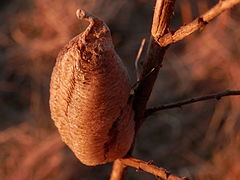User:Aramos1827/sandbox
 | This is a user sandbox of Aramos1827. You can use it for testing or practicing edits. This is not the sandbox where you should draft your assigned article for a dashboard.wikiedu.org course. To find the right sandbox for your assignment, visit your Dashboard course page and follow the Sandbox Draft link for your assigned article in the My Articles section. |

An ootheca /oʊ.əˈθiːkə/ (pl. oothecae /oʊ.əˈθiːsiː/) is a type of egg mass made by any member of a variety of species (usually insects or mollusks).
The word is a Latinized combination of oo-, meaning "egg", from the Greek word ōon (cf. Latin ovum), and theca, meaning a "cover" or "container", from the Greek theke. Ootheke is Greek for ovary.
An ootheca usually contains many eggs surrounded by a foam of protein which then hardens into a tough casing for protection. Notable ootheca-making insects are the mantis and cockroach.[1]
It is formed by secretion of collateral glands, over 16 fertilized eggs are arranged in 2 rows of 8 each. They are found in genital pouch of female cockroach or mantis. The production of ootheca convergently evolved across numerous insect species due to a selection for protection from parasites and other forms of predation, as the complex structure of the shell casing provides an evolutionary reproductive advantage (although fitness and lifespan also depend on other factors such as the temperature of the incubating ootheca).
Image gallery[edit]
-
Female cockroach (Periplaneta fuliginosa) with ootheca
-
Female cockroach with ootheca
-
Sagittal section of mantis ootheca (Hierodula patellifera) already hatched out
-
Praying mantis (Mantis religiosa) Ootheca in Guelph, Ontario, Canada.
-
Damaged praying mantis (Mantis religiosa) ootheca in Guelph, Ontario, Canada.
-
Ootheca of a blattodea
See also[edit]
- Sang piao xiao, mantis oothecae used in traditional Chinese medicine
References[edit]
- ^ Grimaldi, David; Engel, Michael S. (2005-05-16). Evolution of the Insects. Cambridge University Press. p. 230. ISBN 9780521821490.
Goldberg, Julia; Bresseel, Joachim; Constant, Jerome; Kneubühler, Bruno; Leubner, Fanny; Michalik, Peter; Bradler, Sven (2015-01-16). "Extreme convergence in egg-laying strategy across insect orders". Scientific Reports. 5 (1). doi:10.1038/srep07825. ISSN 2045-2322.
Tee, Hui-Siang; Lee, Chow-Yang (2017-02-01). "Influences of Temperature and Ootheca Age on the Life History of the Cockroach Ootheca Parasitoid Aprostocetus hagenowii (Hymenoptera: Eulophidae)". Journal of Economic Entomology. 110 (1): 213–220. doi:10.1093/jee/tow287. ISSN 0022-0493.
External links[edit]







